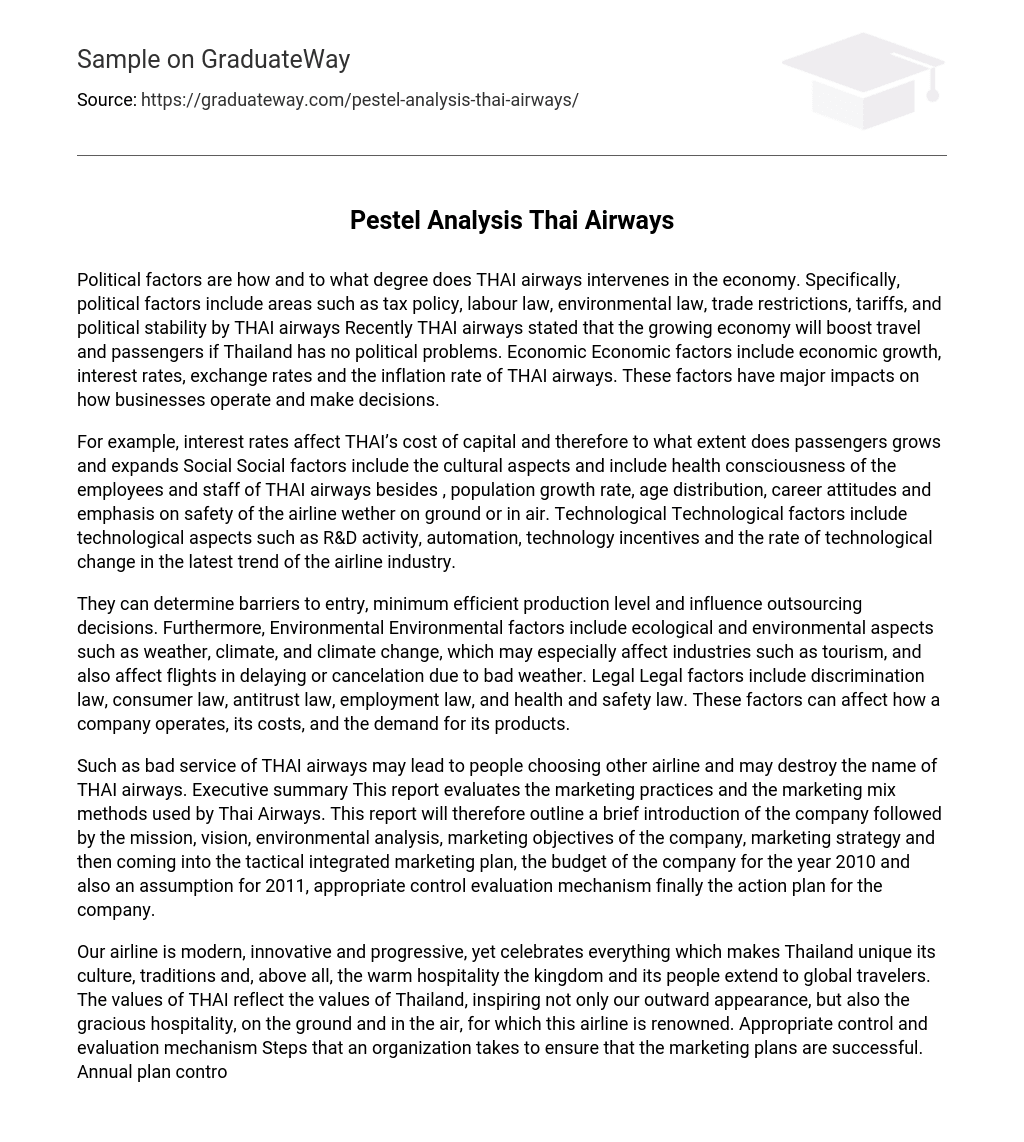Political factors are how and to what degree does THAI airways intervenes in the economy. Specifically, political factors include areas such as tax policy, labour law, environmental law, trade restrictions, tariffs, and political stability by THAI airways Recently THAI airways stated that the growing economy will boost travel and passengers if Thailand has no political problems. Economic Economic factors include economic growth, interest rates, exchange rates and the inflation rate of THAI airways. These factors have major impacts on how businesses operate and make decisions.
For example, interest rates affect THAI’s cost of capital and therefore to what extent does passengers grows and expands Social Social factors include the cultural aspects and include health consciousness of the employees and staff of THAI airways besides , population growth rate, age distribution, career attitudes and emphasis on safety of the airline wether on ground or in air. Technological Technological factors include technological aspects such as R&D activity, automation, technology incentives and the rate of technological change in the latest trend of the airline industry.
They can determine barriers to entry, minimum efficient production level and influence outsourcing decisions. Furthermore, Environmental Environmental factors include ecological and environmental aspects such as weather, climate, and climate change, which may especially affect industries such as tourism, and also affect flights in delaying or cancelation due to bad weather. Legal Legal factors include discrimination law, consumer law, antitrust law, employment law, and health and safety law. These factors can affect how a company operates, its costs, and the demand for its products.
Such as bad service of THAI airways may lead to people choosing other airline and may destroy the name of THAI airways. Executive summary This report evaluates the marketing practices and the marketing mix methods used by Thai Airways. This report will therefore outline a brief introduction of the company followed by the mission, vision, environmental analysis, marketing objectives of the company, marketing strategy and then coming into the tactical integrated marketing plan, the budget of the company for the year 2010 and also an assumption for 2011, appropriate control evaluation mechanism finally the action plan for the company.
Our airline is modern, innovative and progressive, yet celebrates everything which makes Thailand unique its culture, traditions and, above all, the warm hospitality the kingdom and its people extend to global travelers. The values of THAI reflect the values of Thailand, inspiring not only our outward appearance, but also the gracious hospitality, on the ground and in the air, for which this airline is renowned. Appropriate control and evaluation mechanism Steps that an organization takes to ensure that the marketing plans are successful. Annual plan control Annual plan control are basically controlled by top management and middle management of THAI airways to examine wether the plan results are being achieved ensure and control sales, market shares, marketing expense, and market based scoreboard analysis.
Profitability control * Are controlled by marketing controller in specific areas to examine where does THAI airways is making and losing money. THAI airways main specific areas are controlling profitability by product, territory, customer, segment, trade channel, order size. Efficiency control Are controlled by line and staff management of THAI airways to evaluate and improve the spending efficiency and impact of marketing expenditure. Controlled by the efficiency of sales force, advertising, sales promotion, distribution. Strategic control * Are controlled by the top management marketing auditor of THAI airways to examine wether the company is pursuing its best opportunities in markets, products and channels. In this strategy THAI airways controls marketing effectiveness, marketing audit, company ethical and social responsibilities.
Evaluation mechanism in terms of sales analysis and market share Sales analysis Thai Airways International (THAI) is the national carrier of Thailand. THAI operates domestic, regional and intercontinental flights. It has employed 27,193 people as of December, 2009. The company recorded revenues of THB202,605 million (approximately $6,207. 8 million) during the financial year ended December 2009. an increase of 1. 3% over 2008. The operating loss of the company was THB18,114 million (approximately $555 million), compared to an operating loss of THB11,264 million (approximately $344. million) during 2007. The net loss was THB21,379 million (approximately $655. 1 million), compared to a net loss of THB4,368 million (approximately $133. 7 million) in 2007. Market share Thai Airways International PCL has stated that its offer of new shares, targeted to raise 15 billion baht ($487 million) in fresh funds, has been priced at 31 baht each, cheaper than what the market expected. Besides THAI airways market shares has a good growth in terms of the financial. And the government of Thailand has itself allocated good growth and positive market shares for the future of THAI airways.





